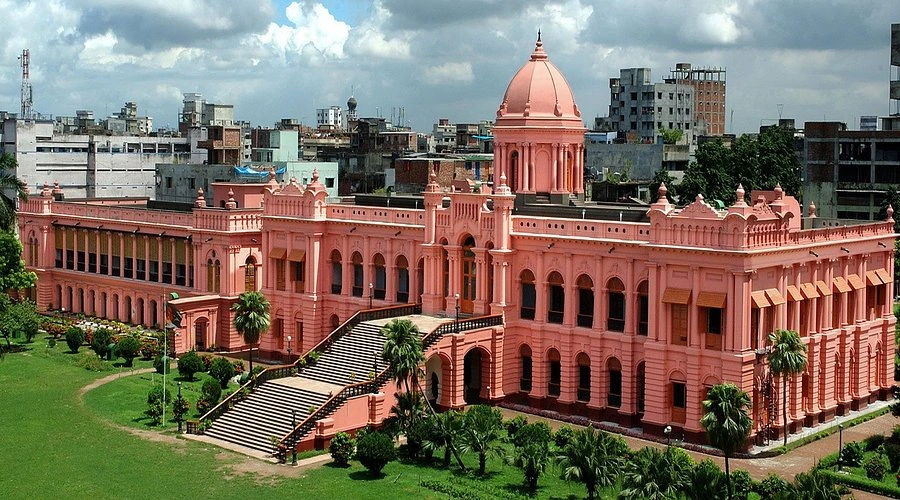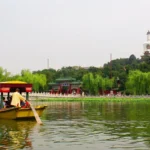Introduction: Why Ahsan Manzil is the Pride of Old Dhaka
When travelers think of historical places in Bangladesh, Ahsan Manzil – better known as the Pink Palace – often tops the list. Overlooking the Buriganga River in Old Dhaka, this 19th-century palace was once the residence of the powerful Nawab family and a center of politics, culture, and aristocracy. Today, it serves as the Ahsan Manzil Museum, offering visitors an extraordinary glimpse into Bangladesh’s rich heritage.
If you are planning an Old Dhaka Tour or looking for the best things to do in Dhaka, visiting Ahsan Manzil is a must. It blends architecture, history, and culture Bangladesh in a way few landmarks can.
Quick Facts about Ahsan Manzil
- Location: Kumartoli, beside the Buriganga River, Old Dhaka
- Construction: 1859–1872
- Architecture: Indo-Saracenic Revival style
- Historical Role: Official residence of the Nawab of Dhaka
- Current Use: National Museum (since 1992)
- Nicknames: Pink Palace, Rangmahal, Ahsan Monjil
- Best Time to Visit: October–March (cooler weather, clear skies)
- Nearby Attractions: Sadarghat River Port, Star Mosque, Shakhari Bazar
Combine your palace visit with a guided Half-Day Tour Dhaka for the ultimate cultural immersion.
The Origins and History of Ahsan Manzil
From Garden House to Nawabi Palace
The site of Ahsan Manzil originally hosted a Mughal-era garden house known as Rangmahal, built by Sheikh Enayet Ullah. Later, French traders established a factory here. In 1830, the property was acquired by Khwaja Alimullah, father of Nawab Abdul Ghani.
Construction of the present palace began in 1859 under Nawab Abdul Ghani and was completed in 1872. He named it Ahsan Manzil after his son, Khwaja Ahsanullah.
Rise and Decline
The palace quickly became a symbol of wealth and aristocracy. It hosted royal guests, political meetings, and cultural events. In 1888, a devastating tornado severely damaged the structure, leading to reconstruction that gave the palace its distinctive dome.
By the 20th century, however, Ahsan Manzil fell into neglect. Parts of the estate were illegally occupied and turned into slums. After independence in 1971, the government intervened to save the monument, officially acquiring it in 1985. Following extensive restoration, it was opened as a museum in 1992.
Architecture of the Pink Palace
Ahsan Manzil is a fine example of Indo-Saracenic Revival architecture.
- Dimensions: 125 meters long, 28 meters wide, two stories tall
- Key Sections:
- Andarmahal (Western block): Living quarters for the Nawab family
- Rangmahal (Eastern block): State rooms, including the ballroom and durbar hall
- Distinctive Features:
- Large central dome added during post-tornado reconstruction
- Triple-arched porticos, broad staircases, and open verandas
- River-facing façade with symmetrical design
For photographers, the palace is a highlight of any Street Photography Tour in Dhaka thanks to its pink façade, domed silhouette, and dramatic riverfront setting.
Inside Ahsan Manzil Museum: What to See
Today, Ahsan Manzil houses more than 20 galleries displaying artifacts from the Nawabi era.
Highlights of the Museum
- Durbar Hall (Palace Hall): Venue for royal banquets and meetings
- Ballroom: Where the Nawabs hosted lavish parties
- Library: Showcasing rare books and documents
- Family Portraits: Paintings of Nawab family members
- Nawab Memorabilia: Jewelry, clothing, musical instruments, and household objects
- Unique Artifacts: The preserved skull of Nawab Abdul Ghani’s favorite elephant, Feroz Jung
Exploring the museum is like stepping back into a different century, where elegance and power shaped daily life.
Ticket Prices and Visiting Hours
- Foreign Visitors: Approx. 200–300 BDT ($2–3)
- Local Visitors: Around 20–40 BDT
- Children under 12: Discounted or free
- Opening Hours: 10 AM – 5 PM (closed on Thursdays)
- Best Visiting Time: Late afternoon for golden light photography
Always check the official Ahsan Manzil Museum notice before visiting, as times can change during Ramadan and national holidays.
How to Reach Ahsan Manzil (Location Guide)
- By CNG/Auto Rickshaw: Ask for “Ahsan Manzil Museum” near Sadarghat
- By Car: Park near Gulistan or Sadarghat and walk a short distance
- By River: A boat ride across the Buriganga gives a stunning view of the Pink Palace
Since the area is part of Old Dhaka City, traffic can be heavy. It’s best to combine the visit with other attractions such as Shakhari Bazar, Lalbagh Fort, and Dhaka Food Tour stops.
Suggested Itinerary: Old Dhaka Tour with Ahsan Manzil
- Morning: Kawran Bazar (Dhaka’s largest wholesale market)
- Mid-Morning: Sadarghat River Port (boat ride experience)
- Late Morning: Visit Ahsan Manzil Museum
- Lunch: Sample biryani or kababs on a guided Dhaka Food Tour
- Afternoon: Armenian Church, Star Mosque, Shakhari Bazar
- Evening: Lalbagh Fort at sunset
Book our Old Dhaka and Sonargao Tour to pair this palace visit with Panam Nagar and Sonargaon’s heritage sites.
Tips for Visitors
- Visit on weekdays to avoid local crowds
- Photography is allowed outside, but flash/tripod use may be restricted inside
- Carry cash for tickets
- Modest dress recommended, especially if combining with mosque visits nearby
- Average visit duration: 1–1.5 hours
Nearby Attractions
- Lalbagh Fort: Mughal fortress with gardens and mosques
- Sadarghat River Port: The bustling heart of Dhaka’s waterways
- Shakhari Bazar: Narrow alleys filled with crafts and street life
- Panam City: Best preserved colonial town near Dhaka (see Visiting Panam City)
Responsible Travel & Conservation
Ahsan Manzil is more than a tourist attraction – it’s a cultural treasure. Visitors are encouraged to:
- Avoid littering and damaging the property
- Support conservation by buying tickets officially
- Hire licensed guides to support local livelihoods
FAQs about Ahsan Manzil
1. Why is Ahsan Manzil famous?
It was the residence of the Nawab of Dhaka and now serves as one of the most important museums in Bangladesh.
2. What is the location of Ahsan Manzil?
It is located in Kumartoli on the Buriganga River in Old Dhaka.
3. What is the architecture style of Ahsan Manzil?
Indo-Saracenic Revival, with Mughal and European influences.
4. What is inside Ahsan Manzil Museum?
Durbar Hall, ballroom, Nawab family memorabilia, paintings, furniture, and artifacts.
5. How much time do you need to visit?
Around 1–1.5 hours for a full tour of the museum.
6. Is it family friendly?
Yes, families enjoy the galleries, architecture, and river views.
Plan Your Visit with Bangladesh Explore
At Bangladesh Explore, we design cultural journeys that go beyond sightseeing. From exploring the World Heritage and Historical Places Tours to immersive experiences like the Sreemangal and Sylhet Tour or Sundarbans and Bagerhat Tour, we are proud to be recognized as the best tour operator in Bangladesh.
If you want to truly Discover Dhaka City, book our guided Ahsan Manzil visit with add-ons like the Dhaka Food Tour or Street Photography Tour in Dhaka for an unforgettable cultural experience.







Looking for a clean vbetlogo design. Found a few, but not quite what I’m after. Anyone have good resources or designers to recommend? A good logo is key, ya know! See some examples at vbetlogo